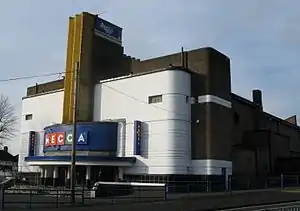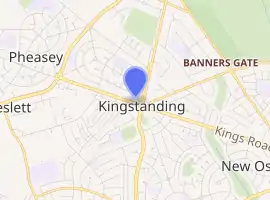Odeon, Kingstanding
The Odeon at Kingstanding, Birmingham, was a 1930s cinema in the Odeon chain. Though closed as a cinema in 1962, the building survives as a bingo hall, and is Grade II listed.
| Odeon Kingstanding | |
|---|---|
 The building in 2014, showing the "Mecca" branding | |

| |
| General information | |
| Architectural style | |
| Location | Kingstanding, Birmingham, England |
| Coordinates | 52.5536°N 1.8856°W |
| Opened | 22 July 1935 |
| Owner | Mecca Bingo |
| Design and construction | |
| Architect | |
History
The cinema was constructed between 1935 and 1936 to a symmetrical, modernist, art deco design by Harry Weedon and Cecil Clavering,[1][2] the latter having joined the former's practice, as an assistant, in 1933.[3] It was commissioned as an independent cinema, and was due to be called "The Beacon",[2] after nearby Barr Beacon, but Oscar Deutsch became involved, and the cinema opened as part of his Odeon chain on 22 July 1935.[2] It was built to serve Kingstanding's new, 4,000-home working-class housing estate[4] and had 968 seats in the stalls and 324 in the circle. The first film was The Lives of a Bengal Lancer, starring Gary Cooper.[2]
The brick building[1] occupies a wedge-shaped site between Kings Road and Kettlehouse Road, overlooking and facing Kingstanding Circle. The centre of the glazed cream and black tile ("faience") frontage features three slender fins, also finished with faience, above a stepped brick parapet.[1][5] Clavering, inspired by the Lichtburg cinema in Berlin, originally intended that these fins would be topped by a searchlight.[6][7]
The cinema closed on 1 December 1962, the final film being To Hell and Back, starring Audie Murphy.[2]
Bingo
The building was refurbished and opened as a Top Rank Bingo Club, subsequently becoming a Mecca Bingo Club, in which use it continues.[8]
It was given Grade-II listed status by English Heritage just 44 years after its erection, on 10 October 1980.[1] It has been described as "one of the best surviving examples of Odeon cinemas in Britain".[3]
References
- "Odeon Cinema Kingstanding, Birmingham". Retrieved 21 February 2014.
- "Odeon Kingstanding in Birmingham, GB". Cinema Treasures. Retrieved 21 February 2014.
- "Odeon, Kingstanding". WalkingArchitecture. Royal Institute of British Architects. 2014. Retrieved 21 February 2014.
- Michael, Chris. "Rediscovering Birmingham's movie meccas". The Guardian. Retrieved 21 February 2014.
- Historic England. "Details from listed building database (1076275)". National Heritage List for England. Retrieved 21 February 2014.
- Allen Eyles, Odeon Cinemas, 2 volumes, volume 1: Oscar Deutsch Entertains Our Nation, London: Cinema Theatre Association, British Film Institute, 2002, ISBN 978-0-85170-813-3, p. 57.
- Richard Gray, Cinemas in Britain: One Hundred Years of Cinema Architecture, London: Lund Humphries, 1996, ISBN 978-0-85331-685-5, p. 92: "The original idea was for a searchlight to be mounted on the fins which would scan the night sky, like at the Lichtburg in Berlin. This idea was dropped when Deutsch took over [the cinema]".
- "Welcome to Mecca Kingstanding". Retrieved 21 February 2014.
External links
| Wikimedia Commons has media related to Odeon Cinema, Kingstanding. |